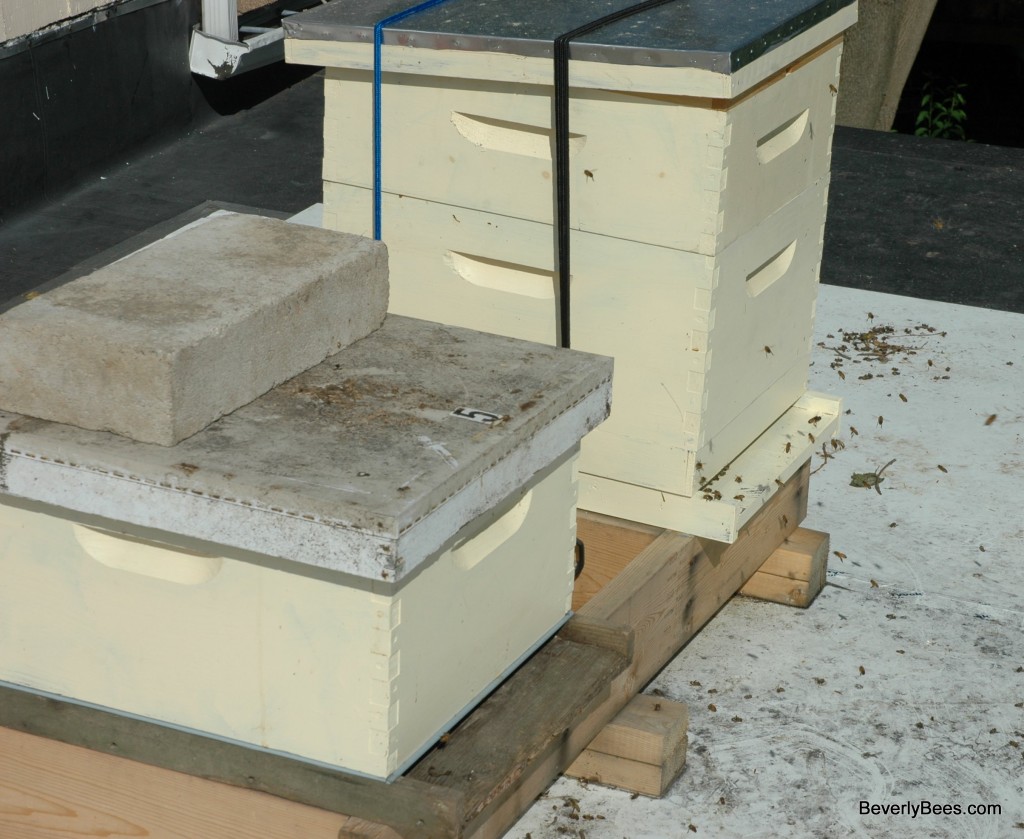And yes, I found that out the hard way.
On June 10th, 2011, my bees swarmed. On June 11th, 2011, I was able to capture them using duct tape, a rock and a string, but the job was incomplete. Now I needed to rehive them.
I took my container of bees onto the roof near my original hive. I didn’t own any extra equipment, so this made splitting my hive a bit of a challenge. I did however have a Snellgrove board from a prior bee emergency. Right before the untimely assassination of my old queen, I thought I needed to split the hive. My husband is very handy (which is great because I am not) and he put together a Snellgrove board for me to use for this purpose. The Snellgrove is a board with a double screen in the middle and three or four doors on each side with levers so you can open and close them. It is used to manipulate bees when you want to run a two queen hive. By opening and closing different doors on the board you can confuse the bees and send them in and out of different areas of the hive depending on which part of the hive you want them to enter.
I placed the Snellgrove board next to my original hive and removed the lever from the front entrance door to give the bees more room to get inside. Next came the queen excluder, this prevents the queen from getting through and keeps her from flying away to initiate swarming again. I split the original hive by taking the top box, which had only 2 drawn frames with bees and put this top box on top of the queen excluder. I put the covers on the old hive and watched as the original hive began fanning. This was important and told me a new queen had hatched out from one of the cells in the original hive. Now I probably had two queens and two hives – very exciting!
Next I placed the branch with the cluster of bees into the box. I clipped the branch so it would fit and removed 6 empty frames to fit the branch right inside the hive. I used a piece of scrap plywood to cover the top and hive # 2 was done. But now what do I do with this giant clump of wet, wriggling, barely clinging to life bees? Would they even live? The clump was a little bigger than a football. If I dumped these wet bees in the hive they would land on top of and soak the dry bees. After speaking to my mentor, I was convinced the only way to save these bees was to dry them out by bringing them inside the house. (Yes, INSIDE THE HOUSE! What was I thinking?) Since the weather was cold and rainy, and it was nighttime now, the bees would not have survived outside in that box for very long.
I didn’t have hardware cloth or an extra window screen to place over the box, but I did have row cover from my garden. Row cover is “supposed to be insect proof” (supposed to be is the key word here). I duct taped the row cover to the plastic container as a lid, checking multiple times that it was securely sealed. Then I took the bees inside and placed them in a warm spot in the basement. I had my doubts about the survival of these soaking wet, barely moving, stuck together in one giant mass, blob of wriggling, legs kicking, pathetic, wet bees.
The next morning a miracle had taken place. The hardly living, clinging to life, wet ball of bees was now flying around in the box and crawling on the underside of the row cover. Almost all of them had sprung back to life. It really was an amazing site to see. These bees appeared to have risen from the dead. For the time being I left them and went to check the new hive.
The bees in the new hive had clustered on the top of the underside of the plywood. They were hanging on for dear life. I cleaned out the debris and then it dawned on me that I had no idea how to put the hive back together. Did I just replace the frames or should I take some nectar filled frames from the other hive? Should I just shake the bees off the plywood cover to make them accept their new home or just leave them in the cluster and hope they go in on their own? So many questions from a new beekeeper. I was not even entirely sure I had captured the queen from the swarm.
I called my mentor Stan and he agreed to come and help again. Thanks Stan! He also said he would bring some extra equipment to borrow for a short time so my bees would have a real home, not a jury rigged one. I decided now was the time to put the bees from the basement back into the hive.

This time when I went into the basement, I was greeted by a dozen or more very angry bees. In the time I had gone outside to work on the hive, the bees I had left inside had chewed a hole in the row cover over the box and several dozen had escaped. There was a light on in the basement and these bees had been repeatedly flying into that light, which was hot, they were getting hurt and getting angrier and angrier. (Really, can you blame them?) It’s a good thing I have a bee suit, I just never expected to have to use it in the house.
Luckily, we have a walk out basement, and since bees fly towards the light I turned all the lights off and opened all the doors hoping they would fly towards the sun instead of the light bulb. Actually, after 8 or so hours it did work, but took an entire day of leaving every door and window open in the rain to let them escape. The things I do for these bees – Jeez. I carefully carried the rest of the bees from the box to the roof and dumped them in the hive. There was instant fanning. A very good sign!
Later that day Stan came over with his bottom board, inner and outer cover and helped me put my hive back together. He used his hive tool to pick up the queen and placed her on the frames letting her walk into the hive. The other bees followed behind and the stragglers got brushed in with the bee brush. Then he just gave them the frames with foundation only. He made it look so easy!
A quick peek at the original hive showed that there was a queen there. She was crawling around on the inner cover, an unusual spot for her to be, but a welcome sign that she was there. Now if I’m lucky I may have a chance at eggs again for the first time in over 2 weeks.
The moral of the story? Wet bees even when they look hopeless can dry out and if you ever have to bring them inside don’t use row cover to lock them in. It’s not as insect proof as it claims.
For more swarmy fun read about how one little bee made my husband run like a baby.
Copyright © 2011-2016. Anita Deeley, BeverlyBees.com. All rights reserved.
